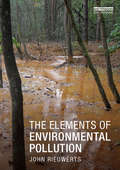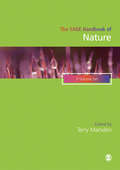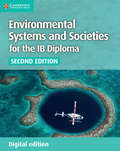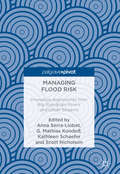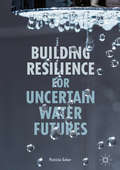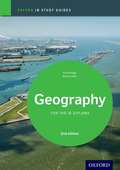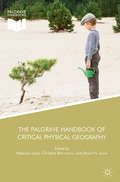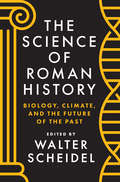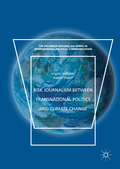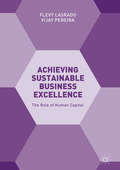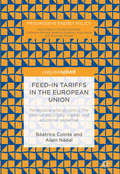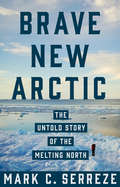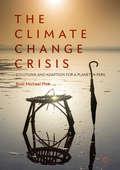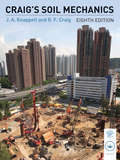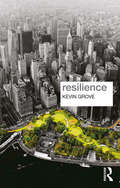- Table View
- List View
The Elements of Environmental Pollution
by John RieuwertsEnvironmental pollution is one of humanity’s most pressing issues and will remain so for the foreseeable future. Anthropogenic activity is disturbing natural cycles and generating pollutants that are altering the atmosphere, accumulating in the food chain and contaminating the world’s soils, rivers and oceans. Human health and ecosystems continue to be damaged by toxic metals, persistent organic pollutants, radionuclides and other hazardous materials. The Elements of Environmental Pollution provides comprehensive coverage of this essential subject. It explains the key principles of pollution science, assesses human disturbances of natural element cycles and describes local and global pollution impacts, from smoggy cities, polluted lakes and toxic soils to climate change, ocean acidification and marine dead zones. The book is informed by the latest pollution research and benefits from numerous real-world examples and international case studies. A comprehensive glossary provides clear and concise explanations of key concepts. This textbook will support teaching and learning in environment-related university courses and will be vital reading for anyone with an interest in environmental protection.
The SAGE Handbook of Nature
by Professor Terry MarsdenThe SAGE Handbook of Nature offers an ambitious retrospective and prospective overview of the field that aims to position Nature, the environment and natural processes, at the heart of interdisciplinary social sciences. The three volumes are divided into the following parts: INTRODUCTION TO THE HANDBOOK NATURAL AND SOCIO-NATURAL VULNERABILITIES: INTERWEAVING THE NATURAL & SOCIAL SCIENCES SPACING NATURES: SUSTAINABLE PLACE MAKING AND ADAPTATION COUPLED AND (DE-COUPLED) SOCIO-ECOLOGICAL SYSTEMS RISK AND THE ENVIRONMENT: SOCIAL THEORIES, PUBLIC UNDERSTANDINGS, & THE SCIENCE-POLICY INTERFACE HUNGRY AND THIRSTY CITIES AND THEIR REGIONS CRITICAL CONSUMERISM AND ITS MANUFACTURED NATURES GENDERED NATURES AND ECO-FEMINISM REPRODUCTIVE NATURES: PLANTS, ANIMALS AND PEOPLE NATURE, CLASS AND SOCIAL INEQUALITY BIO-SENSITIVITY & THE ECOLOGIES OF HEALTH THE RESOURCE NEXUS AND ITS RELEVANCE SUSTAINABLE URBAN COMMUNITIES RURAL NATURES AND THEIR CO-PRODUCTION This handbook is a key critical research resource for researchers and practitioners across the social sciences and their contributions to related disciplines associated with the fast developing interdisciplinary field of sustainability science.
Environmental Systems and Societies for the IB Diploma Digital Edition (IB Diploma)
by Paul Guinness Brenda WalpoleEnvironmental Systems and Societies for the IB Diploma follows the latest syllabus for first examination in 2017. Environmental Systems and Societies for the IB Diploma, 2nd edition, encourages critical and reflective thinking skills and promotes international-mindedness. Real-world case studies bring theory to life and motivate students to delve into current global issues. Theory of Knowledge is integrated throughout with added discussion points to spark debate in class. Exam-style questions build skills on analysis, evaluation and interpretation. Additional teacher support offers help with planning lessons, differentiated learning and guidance about the Internal Assessment, fieldwork, exam preparation and Extended Essay. This Digital Edition is available in a reflowable format, adapting to any screen size or device.
The SAGE Handbook of Nature
by Professor Terry MarsdenThe SAGE Handbook of Nature offers an ambitious retrospective and prospective overview of the field that aims to position Nature, the environment and natural processes, at the heart of interdisciplinary social sciences. The three volumes are divided into the following parts: INTRODUCTION TO THE HANDBOOK NATURAL AND SOCIO-NATURAL VULNERABILITIES: INTERWEAVING THE NATURAL & SOCIAL SCIENCES SPACING NATURES: SUSTAINABLE PLACE MAKING AND ADAPTATION COUPLED AND (DE-COUPLED) SOCIO-ECOLOGICAL SYSTEMS RISK AND THE ENVIRONMENT: SOCIAL THEORIES, PUBLIC UNDERSTANDINGS, & THE SCIENCE-POLICY INTERFACE HUNGRY AND THIRSTY CITIES AND THEIR REGIONS CRITICAL CONSUMERISM AND ITS MANUFACTURED NATURES GENDERED NATURES AND ECO-FEMINISM REPRODUCTIVE NATURES: PLANTS, ANIMALS AND PEOPLE NATURE, CLASS AND SOCIAL INEQUALITY BIO-SENSITIVITY & THE ECOLOGIES OF HEALTH THE RESOURCE NEXUS AND ITS RELEVANCE SUSTAINABLE URBAN COMMUNITIES RURAL NATURES AND THEIR CO-PRODUCTION This handbook is a key critical research resource for researchers and practitioners across the social sciences and their contributions to related disciplines associated with the fast developing interdisciplinary field of sustainability science.
Managing Flood Risk: Innovative Approaches from Big Floodplain Rivers and Urban Streams
by Anna Serra-Llobet G. Mathias Kondolf Kathleen Schaefer Scott NicholsonThe past half century has seen an evolution in thinking from ‘flood control’ to ‘flood risk management’, recognizing that risk results from both hazard and vulnerability. Rather than rely only on engineering structures to reduce flood magnitude or extent, recent policies emphasize avoiding construction in flood-prone areas (or moving people from floodplains), reducing impacts on exposed populations through early warning systems, and insurance to aid in recovery. Implementing this new approach faces many challenges but also offers opportunities for synergies, as described in this book for a range of large floodplain rivers and smaller urban streams across North America and Europe. This book is unique in presenting the voices of those on the front lines of implementing a new paradigm in flood risk management, each river with a unique set of challenges and opportunities derived from its specific geography as well as differences in governance between the American and European contexts.
Managing Flood Risk: Innovative Approaches from Big Floodplain Rivers and Urban Streams
by Anna Serra-Llobet G. Mathias Kondolf Kathleen Schaefer Scott NicholsonThe past half century has seen an evolution in thinking from ‘flood control’ to ‘flood risk management’, recognizing that risk results from both hazard and vulnerability. Rather than rely only on engineering structures to reduce flood magnitude or extent, recent policies emphasize avoiding construction in flood-prone areas (or moving people from floodplains), reducing impacts on exposed populations through early warning systems, and insurance to aid in recovery. Implementing this new approach faces many challenges but also offers opportunities for synergies, as described in this book for a range of large floodplain rivers and smaller urban streams across North America and Europe. This book is unique in presenting the voices of those on the front lines of implementing a new paradigm in flood risk management, each river with a unique set of challenges and opportunities derived from its specific geography as well as differences in governance between the American and European contexts.
Building Resilience for Uncertain Water Futures
by Patricia GoberThis book describes the existential threats facing the global water systems from population growth and economic development, unsustainable use, environmental change, and weak and fragmented governance. It argues that ‘business-as-usual’ water science and management cannot solve global water problems because today’s water systems are increasingly complex and face uncertain future conditions. Instead, a more holistic, strategic, agile and publically engaged process of water decision making is needed.Building Resilience for Uncertain Water Futures emphasises the importance of adaptation through a series of case studies of cities, regions, and communities that have experimented with anticipatory policy-making, scenario development, and public engagement. By shifting perspective from an emphasis on management to one of adaptation, the book emphasizes the capacity to manage uncertainties, the need for cross-sector coordination, and mechanisms for engaging stakeholder with differing goals and conflict resolution. This book will be a useful resource for students and academics seeking a better understanding of sustainable water use, water policy and water resources management.
Building Resilience for Uncertain Water Futures
by Patricia GoberThis book describes the existential threats facing the global water systems from population growth and economic development, unsustainable use, environmental change, and weak and fragmented governance. It argues that ‘business-as-usual’ water science and management cannot solve global water problems because today’s water systems are increasingly complex and face uncertain future conditions. Instead, a more holistic, strategic, agile and publically engaged process of water decision making is needed.Building Resilience for Uncertain Water Futures emphasises the importance of adaptation through a series of case studies of cities, regions, and communities that have experimented with anticipatory policy-making, scenario development, and public engagement. By shifting perspective from an emphasis on management to one of adaptation, the book emphasizes the capacity to manage uncertainties, the need for cross-sector coordination, and mechanisms for engaging stakeholder with differing goals and conflict resolution. This book will be a useful resource for students and academics seeking a better understanding of sustainable water use, water policy and water resources management.
IB Geography Study Guide: Oxford IB Diploma Programme (PDF)
by Garrett Nagel Briony CookePrepare learners for IB assessment. Fully updated to cover the revised syllabus for first examination 2019, this comprehensive Study Guide reinforces the essential understanding learners need for IB exams. With an accessible format that clarifies and explains all the essential principles, this book supports maximum achievement in assessment. Achieve in IB assessment reinforce and master the essential understanding Fully grasp the key principles concise and focused approach simplifies complex ideas, building confident comprehension Fully matched to the revised syllabus first examined 2019 with complete support for the internal and external assessments Clear language optimally supports EAL learners
The Palgrave Handbook of Critical Physical Geography
by Rebecca Lave Christine Biermann Stuart N. LaneThis handbook is recognition of the need to better integrate physical and human geography. It combines a collection of work and research within the new field of Critical Physical Geography, which gives critical attention to relations of social power with deep knowledge of a particular field of biophysical science. Critical Physical Geography research accords careful attention to biophysical landscapes and the power relations that have increasingly come to shape them, and to the politics of environmental science and the role of biophysical inquiry in promoting social and environmental justice. The Palgrave Handbook of Critical Physical Geography lays out the scope and guiding principles of Critical Physical Geography research. It presents a carefully selected set of empirical work, demonstrating the range and intellectual strength of existing integrative work in geography research. This handbook is the first of its kind to cover this emerging discipline and will be of significant interest to students and academics across the fields of geography, the environment and sustainability.
The Palgrave Handbook of Critical Physical Geography
by Rebecca Lave Christine Biermann Stuart N. LaneThis handbook is recognition of the need to better integrate physical and human geography. It combines a collection of work and research within the new field of Critical Physical Geography, which gives critical attention to relations of social power with deep knowledge of a particular field of biophysical science. Critical Physical Geography research accords careful attention to biophysical landscapes and the power relations that have increasingly come to shape them, and to the politics of environmental science and the role of biophysical inquiry in promoting social and environmental justice. The Palgrave Handbook of Critical Physical Geography lays out the scope and guiding principles of Critical Physical Geography research. It presents a carefully selected set of empirical work, demonstrating the range and intellectual strength of existing integrative work in geography research. This handbook is the first of its kind to cover this emerging discipline and will be of significant interest to students and academics across the fields of geography, the environment and sustainability.
The Science of Roman History: Biology, Climate, and the Future of the Past
by Walter ScheidelHow the latest cutting-edge science offers a fuller picture of life in Rome and antiquityThis groundbreaking book provides the first comprehensive look at how the latest advances in the sciences are transforming our understanding of ancient Roman history. Walter Scheidel brings together leading historians, anthropologists, and geneticists at the cutting edge of their fields, who explore novel types of evidence that enable us to reconstruct the realities of life in the Roman world.Contributors discuss climate change and its impact on Roman history, and then cover botanical and animal remains, which cast new light on agricultural and dietary practices. They exploit the rich record of human skeletal material--both bones and teeth—which forms a bio-archive that has preserved vital information about health, nutritional status, diet, disease, working conditions, and migration. Complementing this discussion is an in-depth analysis of trends in human body height, a marker of general well-being. This book also assesses the contribution of genetics to our understanding of the past, demonstrating how ancient DNA is used to track infectious diseases, migration, and the spread of livestock and crops, while the DNA of modern populations helps us reconstruct ancient migrations, especially colonization.Opening a path toward a genuine biohistory of Rome and the wider ancient world, The Science of RomanHistory offers an accessible introduction to the scientific methods being used in this exciting new area of research, as well as an up-to-date survey of recent findings and a tantalizing glimpse of what the future holds.
The Science of Roman History: Biology, Climate, and the Future of the Past
by Walter ScheidelHow the latest cutting-edge science offers a fuller picture of life in Rome and antiquityThis groundbreaking book provides the first comprehensive look at how the latest advances in the sciences are transforming our understanding of ancient Roman history. Walter Scheidel brings together leading historians, anthropologists, and geneticists at the cutting edge of their fields, who explore novel types of evidence that enable us to reconstruct the realities of life in the Roman world.Contributors discuss climate change and its impact on Roman history, and then cover botanical and animal remains, which cast new light on agricultural and dietary practices. They exploit the rich record of human skeletal material--both bones and teeth—which forms a bio-archive that has preserved vital information about health, nutritional status, diet, disease, working conditions, and migration. Complementing this discussion is an in-depth analysis of trends in human body height, a marker of general well-being. This book also assesses the contribution of genetics to our understanding of the past, demonstrating how ancient DNA is used to track infectious diseases, migration, and the spread of livestock and crops, while the DNA of modern populations helps us reconstruct ancient migrations, especially colonization.Opening a path toward a genuine biohistory of Rome and the wider ancient world, The Science of RomanHistory offers an accessible introduction to the scientific methods being used in this exciting new area of research, as well as an up-to-date survey of recent findings and a tantalizing glimpse of what the future holds.
Risk Journalism between Transnational Politics and Climate Change (The\palgrave Macmillan Series In International Political Communication Ser.)
by Ingrid Volkmer Kasim SharifRisk Journalism between Transnational Politics and Climate Change
Achieving Sustainable Business Excellence: The Role of Human Capital
by Vijay Pereira Flevy LasradoCompiling the best practices of business excellence frameworks around the world, this new book addresses the need for innovative research on sustainable business performance. Using detailed empirical studies, the authors outline the motives and benefits of the implementation of such frameworks in different geographical regions. Comprehensive case studies showcase how the variety of excellence frameworks are manifested in their work cultures, values and beliefs. Academics studying quality management, HRM, and international business will find this book an essential read as it establishes the relevance of human capital in achieving and sustaining global business excellence.
Achieving Sustainable Business Excellence: The Role of Human Capital
by Vijay Pereira Flevy LasradoCompiling the best practices of business excellence frameworks around the world, this new book addresses the need for innovative research on sustainable business performance. Using detailed empirical studies, the authors outline the motives and benefits of the implementation of such frameworks in different geographical regions. Comprehensive case studies showcase how the variety of excellence frameworks are manifested in their work cultures, values and beliefs. Academics studying quality management, HRM, and international business will find this book an essential read as it establishes the relevance of human capital in achieving and sustaining global business excellence.
Feed-in tariffs in the European Union: Renewable energy policy, the internal electricity market and economic expertise (Progressive Energy Policy)
by Béatrice Cointe Alain NadaïThis book is a sociological account of the historical trajectory of feed-in tariffs (FITs) as an instrument for the promotion of renewable energy in Europe. Chapters analyse the emergence and transformations of feed-in tariffs as part of the policy arsenal developed to encourage the creation of markets for RES-E in Europe. The authors explore evolving conceptions of renewable energy policy at the intersection between environmental objectives, technological change and the ambition to liberalise the internal electricity market. They draw conclusions on the relationships between markets and policy-making as it is instituted in the European Union, and on the interplay between the implementation of a European vision on energy and national politics. Distinctive in both its approach and its methods the books aim is not to discuss the design of feed-in tariffs and their evolution, nor is it to assess their efficiency or fairness. Instead, the authors seek to understand what makes feed-in tariffs what they are, and how this has changed over time.
Feed-in tariffs in the European Union: Renewable energy policy, the internal electricity market and economic expertise (Progressive Energy Policy)
by Béatrice Cointe Alain NadaïThis book is a sociological account of the historical trajectory of feed-in tariffs (FITs) as an instrument for the promotion of renewable energy in Europe. Chapters analyse the emergence and transformations of feed-in tariffs as part of the policy arsenal developed to encourage the creation of markets for RES-E in Europe. The authors explore evolving conceptions of renewable energy policy at the intersection between environmental objectives, technological change and the ambition to liberalise the internal electricity market. They draw conclusions on the relationships between markets and policy-making as it is instituted in the European Union, and on the interplay between the implementation of a European vision on energy and national politics. Distinctive in both its approach and its methods the books aim is not to discuss the design of feed-in tariffs and their evolution, nor is it to assess their efficiency or fairness. Instead, the authors seek to understand what makes feed-in tariffs what they are, and how this has changed over time.
Brave New Arctic: The Untold Story of the Melting North (Science Essentials)
by Mark C. SerrezeAn insider account of how researchers unraveled the mystery of the thawing ArcticIn the 1990s, researchers in the Arctic noticed that floating summer sea ice had begun receding. This was accompanied by shifts in ocean circulation and unexpected changes in weather patterns throughout the world. The Arctic's perennially frozen ground, known as permafrost, was warming, and treeless tundra was being overtaken by shrubs. What was going on? Brave New Arctic is Mark Serreze's riveting firsthand account of how scientists from around the globe came together to find answers.In a sweeping tale of discovery spanning three decades, Serreze describes how puzzlement turned to concern and astonishment as researchers came to understand that the Arctic of old was quickly disappearing--with potentially devastating implications for the entire planet. Serreze is a world-renowned Arctic geographer and climatologist who has conducted fieldwork on ice caps, glaciers, sea ice, and tundra in the Canadian and Alaskan Arctic. In this must-read book, he blends invaluable insights from his own career with those of other pioneering scientists who, together, ushered in an exciting new age of Arctic exploration. Along the way, he accessibly describes the cutting-edge science that led to the alarming conclusion that the Arctic is rapidly thawing due to climate change, that humans are to blame, and that the global consequences are immense.A gripping scientific adventure story, Brave New Arctic shows how the Arctic's extraordinary transformation serves as a harbinger of things to come if we fail to meet the challenge posed by a warming Earth.
Brave New Arctic: The Untold Story of the Melting North (Science Essentials)
by Mark C. SerrezeAn insider account of how researchers unraveled the mystery of the thawing ArcticIn the 1990s, researchers in the Arctic noticed that floating summer sea ice had begun receding. This was accompanied by shifts in ocean circulation and unexpected changes in weather patterns throughout the world. The Arctic's perennially frozen ground, known as permafrost, was warming, and treeless tundra was being overtaken by shrubs. What was going on? Brave New Arctic is Mark Serreze's riveting firsthand account of how scientists from around the globe came together to find answers.In a sweeping tale of discovery spanning three decades, Serreze describes how puzzlement turned to concern and astonishment as researchers came to understand that the Arctic of old was quickly disappearing--with potentially devastating implications for the entire planet. Serreze is a world-renowned Arctic geographer and climatologist who has conducted fieldwork on ice caps, glaciers, sea ice, and tundra in the Canadian and Alaskan Arctic. In this must-read book, he blends invaluable insights from his own career with those of other pioneering scientists who, together, ushered in an exciting new age of Arctic exploration. Along the way, he accessibly describes the cutting-edge science that led to the alarming conclusion that the Arctic is rapidly thawing due to climate change, that humans are to blame, and that the global consequences are immense.A gripping scientific adventure story, Brave New Arctic shows how the Arctic's extraordinary transformation serves as a harbinger of things to come if we fail to meet the challenge posed by a warming Earth.
Brave New Arctic: The Untold Story of the Melting North (Science Essentials)
by Mark C. SerrezeAn insider account of how researchers unraveled the mystery of the thawing ArcticIn the 1990s, researchers in the Arctic noticed that floating summer sea ice had begun receding. This was accompanied by shifts in ocean circulation and unexpected changes in weather patterns throughout the world. The Arctic's perennially frozen ground, known as permafrost, was warming, and treeless tundra was being overtaken by shrubs. What was going on? Brave New Arctic is Mark Serreze's riveting firsthand account of how scientists from around the globe came together to find answers.In a sweeping tale of discovery spanning three decades, Serreze describes how puzzlement turned to concern and astonishment as researchers came to understand that the Arctic of old was quickly disappearing--with potentially devastating implications for the entire planet. Serreze is a world-renowned Arctic geographer and climatologist who has conducted fieldwork on ice caps, glaciers, sea ice, and tundra in the Canadian and Alaskan Arctic. In this must-read book, he blends invaluable insights from his own career with those of other pioneering scientists who, together, ushered in an exciting new age of Arctic exploration. Along the way, he accessibly describes the cutting-edge science that led to the alarming conclusion that the Arctic is rapidly thawing due to climate change, that humans are to blame, and that the global consequences are immense.A gripping scientific adventure story, Brave New Arctic shows how the Arctic's extraordinary transformation serves as a harbinger of things to come if we fail to meet the challenge posed by a warming Earth.
The Climate Change Crisis
by Ross Michael PinkThis book explores how the world community will respond to the unfolding humanitarian crisis caused by climate change. It recognises climate change as the greatest threat to human development in the 21st century, bringing with it: flooding, drought, extreme temperatures, health crises, threats to human security and severe harm to economic development.The Climate Change Crisis addresses climate change and its impact as a major threat for countries around the world. Through a collection of interviews with leading environmentalists and exploration into new innovations that can offer hope and protection for billions of people, this book presents an interdisciplinary approach towards understanding the paramount health and development challenges of climate change.This timely and informative book cuts across several disciplines, including human rights, public policy, international relations, national refugee policy, and migration studies.
Craig's Soil Mechanics
by R. F. Craig Jonathan KnappettNow in its eighth edition, this bestselling text continues to blend clarity of explanation with depth of coverage to present students with the fundamental principles of soil mechanics. From the foundations of the subject through to its application in practice, Craig’s Soil Mechanics provides an indispensable companion to undergraduate courses and beyond. New to this edition: Rewritten throughout in line with Eurocode 7, with reference to other international standards Restructured into two major sections dealing with the basic concepts and theories in soil mechanics and the application of these concepts within geotechnical engineering design New topics include limit analysis techniques, in-situ testing, and foundation systems Additional material on seepage, soil stiffness, the critical state concept, and foundation design Enhanced pedagogy including a comprehensive glossary, learning outcomes, summaries, and visual examples of real-life engineering equipment Also new to this edition is an extensive companion website comprising innovative spreadsheet tools for tackling complex problems, digital datasets to accompany worked examples and problems, a password-protected solutions manual for lecturers covering the end-of-chapter problems, weblinks, extended case studies, and more.
Craig's Soil Mechanics (PDF)
by R. F. Craig Jonathan KnappettNow in its eighth edition, this bestselling text continues to blend clarity of explanation with depth of coverage to present students with the fundamental principles of soil mechanics. From the foundations of the subject through to its application in practice, Craig’s Soil Mechanics provides an indispensable companion to undergraduate courses and beyond. New to this edition: Rewritten throughout in line with Eurocode 7, with reference to other international standards Restructured into two major sections dealing with the basic concepts and theories in soil mechanics and the application of these concepts within geotechnical engineering design New topics include limit analysis techniques, in-situ testing, and foundation systems Additional material on seepage, soil stiffness, the critical state concept, and foundation design Enhanced pedagogy including a comprehensive glossary, learning outcomes, summaries, and visual examples of real-life engineering equipment Also new to this edition is an extensive companion website comprising innovative spreadsheet tools for tackling complex problems, digital datasets to accompany worked examples and problems, a password-protected solutions manual for lecturers covering the end-of-chapter problems, weblinks, extended case studies, and more.
Resilience (Key Ideas In Geography Ser.)
by Kevin GroveIs resilience simply a fad, or is it a new way of thinking about human–environment relations, and the governance of these relations, that has real staying power? Is resilience a dangerous, depoliticizing concept that neuters incipient political activity, or the key to more empowering, emancipatory, and participatory forms of environmental management? Resilience offers an advanced introduction to these debates. It provides students with a detailed review of how the concept emerged from a small corner of ecology to critically challenge conventional environmental management practices, and radicalize how we can think about and manage social and ecological change. But Resilience also situates this new style of thought and management within a particular historical and geographical context. It traces the roots of resilience to the cybernetically-influenced behavioral science of Herbert Simon, the neoliberal political economic theory of new institutional economics, the pragmatist philosophy of John Dewey, and the modernist design aesthetic of the Bauhaus school. These diverse roots are what distinguish resilience approaches from other ways of studying human-environment relations. Resilience thinking recalibrates the study of social and environmental change around a will to design, a drive or desire to synthesize diverse forms of knowledge and develop collaborative, cross-boundary solutions to complex problems. In contrast to the modes of analysis and critique found in geography and cognate disciplines, resilience approaches strive to pragmatically transform human–environment relations in ways that will produce more sustainable futures for complex social and ecological systems. In providing a road map to debates over resilience that brings together research from geography, anthropology, sociology, international relations, and philosophy, this book gives readers the conceptual and theoretical tools necessary to engage with political and ethical questions about how we can and should live together in an increasingly interconnected and unpredictable world.
